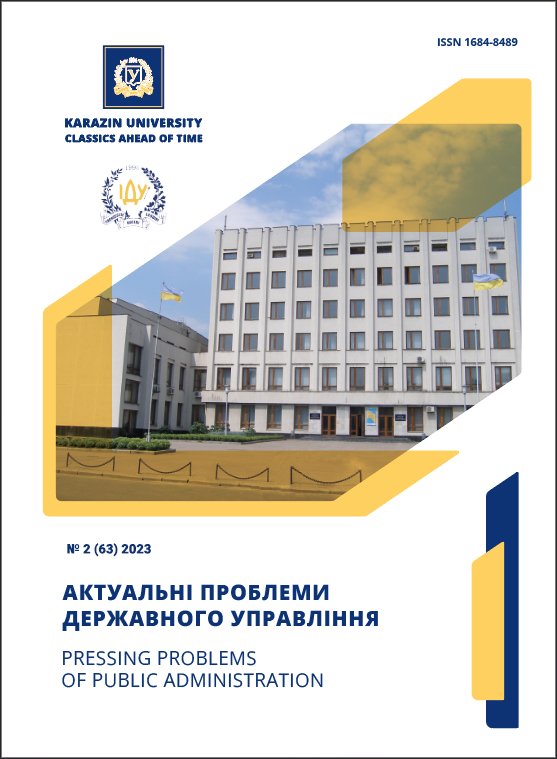Теоретичні аспекти формування сталої системи промислового і кадрового відновлення в регіоні у повоєнний період
Анотація
Стаття акцентує увагу на важливості методологічного підходу до побудови системи сталого промислового відновлення і залучення кваліфікованої робочої сили в регіональну економіку навіть під час війни. Мета статті – наукове обґрунтування понятійного апарату та методико-теоретичної основи відновлення промислового потенціалу українських регіонів у період дії воєнного стану. Автор зауважує, що ключовим елементом у процесі формування системи сталого промислового відновлення є розуміння масштабів збитків та наявність кваліфікованої робочої сили для відновлення по сектральних пріоритетах. Це вимагає широкого наукового погляду на цю екстраординарну проблему і, як наслідок, комплексного підходу.
Такий підхід поєднував би і аналіз поточного стану промислових об’єктів, визначення потреби у кадрах і ресурсах для модернізації з урахуванням як місцевих ресурсів, так і зовнішніх факторів, включаючи доступність фінансування, технологічні інновації та міжнародну підтримку. Станом на зараз можна фіксувати досі певні термінологічні і наукові «прогалини» у принципах організації відновлення і понятійному апараті, який стосувався би відновлювальних процесів в промисловому секторі України сьогодні. Стаття розкриває термінологію для перегляду системи сталого промислового відновлення у період дії воєнного стану і після Перемоги як передумови повоєнного відновлення та сталого розвитку регіонів, що є базовою умовою пошуку та реалізації шляхів оптимального використання наявних ресурсів, подолання технологічних розривів та створення умов для повернення кваліфікованих мігрантів в Україну
Завантаження
Посилання
Adamska, O. (2018). Crisis management in the context of responding to regional challenges: Theoretical and methodological aspect. Efficiency of Public Administration, 2(55), Part 1, 30–38. [in Ukrainian].
Bakumenko, V. (2011). Project management. In Y. Levenets (Ed.), Political Encyclopedia. Kyiv: Parliamentary Publishing. [in Ukrainian].
Gibadullin, O.G. (2021). Theoretical and methodological aspects of state regulation of innovative development of the trade and industrial sphere of Ukraine’s economy. Theory and History of Public Administration, 1(82). Retrieved from http://uran.oridu.odessa.ua/article/view/229119.
DOI: https://doi.org/10.35432/1993-8330appa1822021229119 [in Ukrainian].
Berezhnyuk, I.G. (Ed.). (2013). History of Risk Profile. Customs Encyclopedia, vol. 1, 472. Khmelnytskyi: PP Melnyk A.A. [in Ukrainian].
Kovalenko, M.M., & Dunaiev, I.V. (2023). Components of public policy in the context of implementing a mobilization model of economic development. Theory and Practice of Public Administration, 1(76), 7–25. URL https://periodicals.karazin.ua/tpdu/article/view/22287/20607
DOI: https://doi.org/10.26565/1727-6667-2023-1-01 [in Ukrainian].
Chubenko, A.G., Loshitsky, M.V., Pavlov, D.M., Bychkova, S.S. & Yunin, O.S. (2018). Risk Criterion. In Terminological Dictionary on Preventing and Countering Money Laundering, Terrorism Financing, Proliferation Financing, and Corruption. Kyiv: Vaite, 378–379. [in Ukrainian].
Melnychenko, O.A. (2015). State anti-crisis policy: Essence and priority directions. Theory and Practice of Public Administration, 2, 17–24 [in Ukrainian].
Nozdrina, L.V., Yashchuk, V.I., & Polotai, O.I. (2010). Project Management: Textbook. Kyiv: Center for Educational Literature. [in Ukrainian].
Shynkaruk, V.I. (Ed.). (2002). Organization. In Philosophical Encyclopedic Dictionary. Kyiv: Hryhoriy Skovoroda Institute of Philosophy, NAS of Ukraine: Abris. [in Ukrainian].
Ostapchuk, O.Ye. A systematic approach to management and decision-making.
URL : http://surl.li/pmiky [in Ukrainian].
Sytnyk, L.S. (2000). Organizational and economic mechanism of enterprise crisis management. Donetsk: Institute of Industrial Economics, NAS of Ukraine. [in Ukrainian].
Sokolik, L. (2022). The use of crowd technologies in the governance system under martial law in Ukraine. Current Problems of Public Administration, 2(61), 38-56. DOI: https://doi.org/10.26565/1684-8489-2022-2-03 [in Ukrainian].
Stanford, L. & Optner, S. (1967). Systems Analysis for Business and Industrial Problem Solving (S. Nikanorova, Trans.). [in Ukrainian].
Bashynska, I. (2020). Management of smartization of business processes of an industrial enterprise to ensure its economic security. Schweinfurt: Time Realities Scientific Group UG (haftungsbeschränkt).
Bertalanfy, L. (1969). General system theory: Foundations, development, applications. New York: Braziller.
Cleland, D. & Gareis, R. (2006). The evolution of project management. In Global project management handbook. McGraw-Hill Professional. URL: https://www.accessengineeringlibrary.com/content/book/9780071460453
Cleland, D. & Gareis, R. (2006). Global project management handbook. McGraw-Hill Professional.
Dinsmore, P. (2005). The right projects done right! John Wiley and Sons. p. 35 and further.
Dunayev, I.V., Gavkalova, N.L. & Kud, A.A. (2023). Designing a platform-based model of civic participation within the smart-city concept for post-war Ukrainian cities. Eastern-European Journal of Enterprise Technologies, 3(14), 46–56. URL: https://journals.uran.ua/eejet/article/view/285448/280508 (SCOPUS) DOI: https://doi.org/10.15587/1729-4061.2023.285448
The International Consortium of Investigative Journalists. (2017). Explore the Panama Papers key figures. URL: https://panamapapers.icij.org/graphs/
Gosling, W. (1962). The design of engineering systems. London: Heywood.
UK Department for Business, Enterprise and Regulatory Reform (BERR). Guidelines for managing projects. URL: https://webarchive.nationalarchives.gov.uk/ukgwa/20090609003228/http://www.berr.gov.uk/files/file40647.pdf
Hall, A. (1962). A methodology for systems engineering. Princeton.
Lewis, R. Ireland (2006). Project management. McGraw-Hill Professional.
Luhmann, N. (1995). Social systems. Stanford: Stanford University Press.
Matusiak, M. (n.d.). Overview of the process of smart specialisation in Ukraine, Moldova and Tunisia. The European Commission’s science and knowledge service. Joint Research Centre.
Wideman, M. (n.d.). Max Wideman’s «Open source» comparative glossary of project management terms. URL: http://www.maxwideman.com/
Phillips, J. (2003). PMP Project Management Professional Study Guide. McGraw-Hill Professional.
Potočnik, G. (2023). Operationalisation of legislation and the will of legislators in the judgments of international courts of war crimes and post-war recovery. The Theory and Practice of Legislation, 11(3), 184–206. DOI: 10.1080/20508840.2023.2248834
Rodríguez-García, C., Martínez-Senra, A. I., Quintás, M., & Vázquez, H. (2024). Overcoming the dark side of subnational start-up support policies: A pilot project for facilitating cross-border cooperation in Europe. Regional Studies. DOI: 10.1080/00343404.2023.2293985
Viega, J.F. (2011). Plateaued versus nonplateaued managers: Career patterns, attitudes and path potentials. Academy of Management Journal, 24(3), 556–578.
Wapshott, R., & Mallett, O. (2018). Small and medium-sized enterprise policy: Designed to fail? Environment and Planning C: Politics and Space, 36(4), 750–772. DOI: https://doi.org/10.1177/2399654417719288
Wethington, E. (2007). The structured life event inventory. In C. Zalaquett & R. Wood (Eds.), Evaluating stress: A book of resources. Lanham, MD: Scarecrow/University Press. pp. 391–405.
Witzel, M. (2003). Fifty key figures in management. Routledge. 96–101. URL: https://www.routledge.com/Fifty-Key-Figures-in-Management/Witzel/p/book/9780415369787
Young-Hoon, K. (2005). A brief history of project management. In The story of managing projects by Elias G. Carayannis et al. (9 eds), Greenwood Publishing Group.
Xheneti, M. (2020). Placing enterprise policy in context: A policy transfer approach.
In D. Smallbone & F. Welter (Eds.), A research agenda for entrepreneurship policy, 31–46. Edward Elgar. DOI: https://doi.org/10.4337/9781786430946.00010

